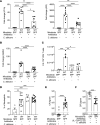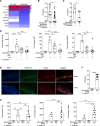A gut-oral microbiome-driven axis controls oropharyngeal candidiasis through retinoic acid
- PMID: 36134659
- PMCID: PMC9675558
- DOI: 10.1172/jci.insight.160348
A gut-oral microbiome-driven axis controls oropharyngeal candidiasis through retinoic acid
Abstract
A side effect of antibiotics is outgrowth of the opportunistic fungus Candida albicans in the oropharynx (oropharyngeal candidiasis, OPC). IL-17 signaling is vital for immunity to OPC, but how the microbiome impacts antifungal immunity is not well understood. Mice in standard specific pathogen-free (SPF) conditions are resistant to OPC, whereas we show that germ-free (GF) or antibiotic-treated mice are susceptible. Oral type 17 cells and IL-17-dependent responses were impaired in antibiotic-treated and GF mice. Susceptibility could be rescued in GF mice by mono-colonization with segmented filamentous bacterium (SFB), an intestine-specific constituent of the microbiota. SFB protection was accompanied by restoration of oral IL-17+CD4+ T cells and gene signatures characteristic of IL-17 signaling. Additionally, RNA-Seq revealed induction of genes in the retinoic acid (RA) and RA receptor-α (RARα) pathway. Administration of RA rescued immunity to OPC in microbiome-depleted or GF mice, while RAR inhibition caused susceptibility in immunocompetent animals. Surprisingly, immunity to OPC was independent of serum amyloids. Moreover, RAR inhibition did not alter oral type 17 cytokine levels. Thus, mono-colonization with a component of the intestinal microflora confers protection against OPC by type 17 and RA/RARα, which act in parallel to promote antifungal immunity. In principle, manipulation of the microbiome could be harnessed to maintain antifungal immunity.
Keywords: Cytokines; Fungal infections; Immunology.
Conflict of interest statement
Figures





References
Publication types
MeSH terms
Substances
Grants and funding
LinkOut - more resources
Full Text Sources
Research Materials

